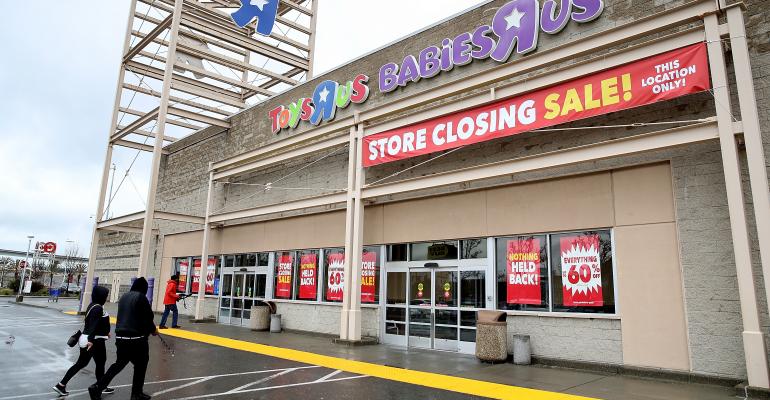(Bloomberg)—Toys “R” Us’s fired workers last week won the right to negotiate for severance money in bankruptcy court, in an unusual victory. They may end up getting nothing.
Before much money can be paid to the retailer’s 33,000 former employees, senior lenders need to collect about $1 billion. For now, the staffers can try to tap a pool of $180 million designated to pay post-bankruptcy bills, but they are competing with other creditors, like toy suppliers and the lawyers and financial advisers helping to dismantle the company. The suppliers alone are entitled to more than 85 percent of the pool at its current size.
The workers are set to disclose on Monday how much money they are asking the bankruptcy court for. Critics of the U.S. bankruptcy process say the Toys “R” Us case underscores a problem with the system: lenders usually end up better off than rank-and-file workers who had little to do with a company’s demise.
“When an outside group with a lot of money can come into a place like Toys ‘R’ Us and vacuum up all the value and leave the employees, leave the pensioners, leave the small-trade, the folks who help supply the business ... and take all the value and leave nothing for anyone else, then capitalism doesn’t work. Markets don’t work,” Senator Elizabeth Warren, a former professor at Harvard Law School who taught bankruptcy, said in an interview.
Long Drama
Workers’ efforts to get severance pay is just one part of the long drama of the decline and fall of Toys “R” Us, which until it began liquidating this year was the largest standalone toy retailer in the U.S. The company took on $5 billion of debt in a leveraged buyout in 2005, a burden that left it ill-equipped to handle competition from Walmart Inc. and Amazon.com. The Wayne, New Jersey-based toy seller is among the biggest of a string of retailers to go under, including Sports Authority and department-store chain Bon-Ton.
Last week, Toys “R” Us lenders as well as Bain Capital, KKR & Co. and Vornado Realty Trust, the firms that took the retailer private, agreed to set aside $180 million to cover "administrative claims," or bills the company generated after it filed for bankruptcy. After lenders like Oaktree Capital Management and Solus Alternative Asset Management that have a first claim on the company’s assets get $1 billion, additional money could flow to administrative claimholders too. Bain, KKR, Vornado, Oaktree and Solus all declined to comment.
It’s not clear how much money will be left over. At the start of June, Toys “R” Us had just $347.2 million of cash. It finished closing its U.S. stores last month. The company can make some extra money by auctioning off its few remaining assets, including its brand name. It’s unlikely that the administrative claimholders will get fully paid, said Melissa B. Jacoby, a bankruptcy professor at the law school at the University of North Carolina at Chapel Hill who has followed the case.
‘Administratively Insolvent’
The company itself still doesn’t know whether it will raise enough money to pay off such claims, said spokeswoman Amy von Walter. In March, a company financial adviser told the judge overseeing the case that Toys “R” Us would probably wind up being “administratively insolvent.” If all the former employees are eligible for payouts, their claims alone could run into the tens of millions of dollars. When Toys “R” Us filed for bankruptcy in September it listed $6.57 billion of assets and $7.89 billion of liabilities.
Historically, Toys “R” Us has offered generous severance to workers, which is part of why it should be forced to offer payments to workers now, said Carrie Gleason, campaign manager for the worker advocacy group Rise Up Retail. That group helped organize a petition calling for Bain, KKR, and Vornado to give the $470 million they had received in interest and fees from the retailer over the years to employees that were let go after the company foundered. KKR told Congress earlier this month it was seeking a way to help former Toys “R” Us employees outside of bankruptcy.
The private equity firms were among the parties that agreed to set aside $180 million for administrative claims that would have otherwise gone to lenders. Separately, last week Toys “R” Us agreed to let employees file a single claim for severance, allowing them to hire one set of lawyers to represent them in bankruptcy. Without that approval, individual employees could have likely found negotiating in the bankruptcy process to be prohibitively expensive. Such combined claims for employees are unusual in bankruptcy court and can involve a protracted fight that drains the company’s resources.
The company said Monday that it hired Raider Hill Advisors to sell the Toys “R” Us headquarters and about 284 properties in 46 states. That land includes warehouses and empty Toys and Babies “R” Us stores.
--With assistance from Lauren Coleman-Lochner, Natasha Rausch, Kevin Cirilli and Vildana Hajric.To contact the reporter on this story: Steven Church in Wilmington, Delaware at [email protected] To contact the editors responsible for this story: Nikolaj Gammeltoft at [email protected] Dan Wilchins, Rick Green
COPYRIGHT
© 2018 Bloomberg L.P

